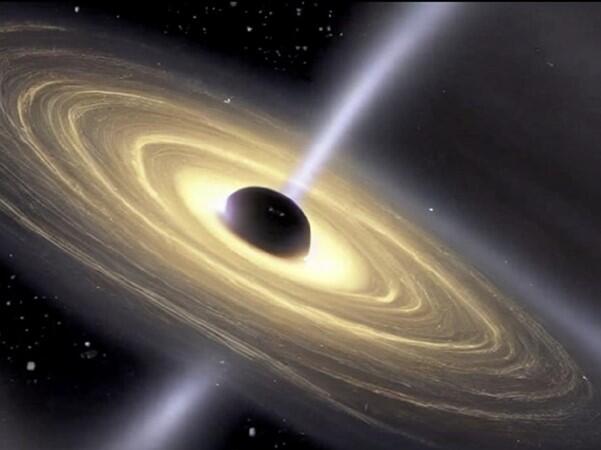A research team led by graduate student Shumpei Nagoshi and Associate Professor Fumihide Iwamuro of the Graduate School of Science, Kyoto University, has successfully revealed that the temporal variation in the brightness of quasars is related to the intensity of specific emission lines emitted by the objects.
Variation in brightness is a known feature of quasars, but its mechanism and relationship to other physical quantities are not understood well. To investigate further, the research team looked at the relationship between emission line intensity and variation in brightness in the spectra of about 10,000 objects from the Sloan Digital Sky Survey (SDSS). They found that the intensity of oxygen and iron emission lines at a given point in time is an important factor in determining the degree of change in brightness later. The team found that the intensity and brightness of the emission lines varied with a certain correlation over the long term.

Provided by Kyoto University
This allowed them to demonstrate the possibility that random fluctuations in quasars could be predicted from the optical spectra. The results also suggested that the large-scale variations in quasars are oscillatory phenomena centered on the average brightness for that source. The spectra are thought to contain information on the typical brightness of an object, and thus provide important clues to the history of quasar mass gain.
In addition to this, the research team conducted a large-scale analysis using spectra of approximately 10,000 objects with large brightness variations. From the acquired spectra, equivalent widths were measured as emission line intensities for iron, oxygen and hydrogen, and the change in emission line intensity and later brightness for each source was plotted. From this, it was found that the emission line intensity calculated from a spectrum at a certain time is closely related to the subsequent change in brightness. By comparing spectra of the same object taken at different times, they studied the amount of variation in emission line intensity associated with the variation in brightness of each object and found that this variation oscillates between a dark state and a bright state with an average state as a boundary.
This informed them that the equivalent width of the quasar's oxygen emission line and its intensity ratio to the iron emission line are closely linked to subsequent brightness variations. Furthermore, the fact that the large-scale fluctuations in quasars were shown to be oscillatory phenomena suggests that the brightness fluctuation phenomena that have been reported in numerous recent years are not temporary but have occurred repeatedly and will continue to occur in the future.
"This research began with a chance discovery made while looking at a large amount of quasar data," explained Nagoshi. "I believe that in the future we need to show the physical process in a more quantitative way. For this reason, we are currently concentrating on quasars that have a large variation in brightness to determine what kind of structure they have. We are also exploring the possibility of tracing the accumulated time-series data back to the earliest days, to see if we can identify changes over a period of up to around 100 years."
■ Quasar: A supermassive black hole at the center of a galaxy (a black hole more than one million times more massive than the sun) that shines brightly.
■ Sloan Digital Sky Survey (SDSS): An observation project with images of more than 25% of the entire sky and has identified the largest number of quasars of any single project.
Journal Information
Publication: Publications of the Astronomical Society of Japan
Title: The relation between quasars' optical spectra and variability
DOI: 10.1093/pasj/psac063
This article has been translated by JST with permission from The Science News Ltd.(https://sci-news.co.jp/). Unauthorized reproduction of the article and photographs is prohibited.




